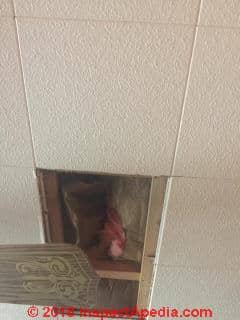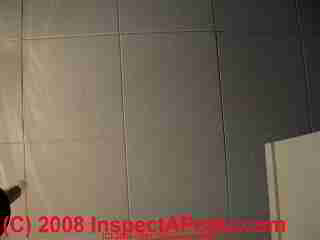 Celotex® Asbestos-Containing Product FAQs
Celotex® Asbestos-Containing Product FAQs
- POST a QUESTION or COMMENT about whether or not certain Celotex® products contained asbestos, including ceiling tiles & insulating sheathing board.
Q&A on asbestos-containing products made by the Celotex corporation.
This article series comments on building products such as ceiling tiles and many other Celotex® brand building products & articles listed by some sources as believed to contain asbestos.
InspectAPedia tolerates no conflicts of interest. We have no relationship with advertisers, products, or services discussed at this website.
- Daniel Friedman, Publisher/Editor/Author - See WHO ARE WE?
Celotex™ Building Products Asbestos FAQs
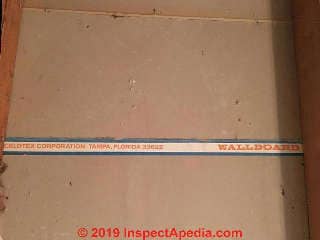 These questions & answers about asbestos in Celotex ceiling tiles or other Celotex products were posted originally
These questions & answers about asbestos in Celotex ceiling tiles or other Celotex products were posted originally
at CELOTEX ASBESTOS PRODUCTS - be sure to see that article.
On 2020-10-16 - by (mod) -
Super.
While the chances are small that your insulation was cross-contaminated with asbestos, I'm naturally interested in any test results. Particularly in our current health, pandemic, and political climate, respecting actual data and facts are the only course that could get us out of the swamp.
Do let us know what's reported.
On 2020-10-16 by Luke
This was all dry from the ceiling I was going to replace from one spot. The house was built in the 1950's so I wasn't sure as to if it contained asbestos or not. I had cleaned up the old squares from the part that had a leak and the insulation that got wet had fell, I pulled a few more off and saw the brand stamped on it thats when i tried to find out more before going further. It will be left the undamaged if safe and spot that was wet replaced with a few pieces of new insulation and then replaced with gypsum/sheetrock. Thanks again! I will send a sample off probably to see if it does have any cross contamination to be sure
On 2020-10-16 - by (mod) -
Luke
In essence, mineral wool is just that - made from mineral fibres, but not asbestos. You should be ok.
But
Watch out: if any of that insulation was wet from the hurricane there is real risk of creating a troublesome hidden mold problem: wet building insulation should be removed, discarded, the cavity area surfaces cleaned, and dried before re-insulating.
On 2020-10-16 by Luke
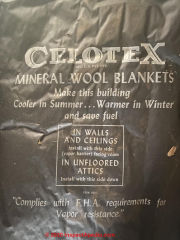
Thank you for your quick reply, I saw the underside of this and took a picture before replacing the ceilings after taking some damage from the two hurricanes recently. I'll check out that list now, thanks again!
On 2020-10-16 by (mod) - asbestos in Celotex Mineral Wool Blankets?
Luke
Your nice photo identifies Celotex mineral wool - which is not an asbestos material.
You may also want to review the question of cross contamination
On 2020-10-16 by Luke
Was wondering if anyone knew weather this attic insulation contains asbestos, thanks in advance!
On 2020-04-21 - by (mod) -
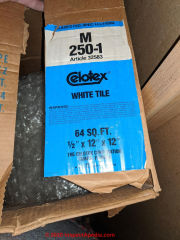 Victor:
Victor:
at CELOTEX ASBESTOS PRODUCTS
at https://inspectapedia.com/hazmat/Celotex_Asbestos_Products_List.php
We have this "Alphabetical list of Celotex™ insulating & other building products believed to contain or not-contain asbestos"
There state "Celotex™ Brand ceiling tiles - Suspended ceiling tiles of the 2'x2' or 2'x4' dimension, and manufactured by Armstrong, Celotex, Conwed, LoTone, and USG and made before the late 1970's are listed by several attorney-sponsored "mesothelioma websites" as often containing asbestos to add fire-resistance."
But what about Celotex fiberboard products, including ceiling tiles?
Regarding your 12x12-inch Celotex ceiling tiles (thanks for the excellent photo and helpful question)
I'm looking to see what else I can find about your Celotex M 250-1 white ceiling tiles and the asbestos question, but so far I've found that
"FS LLL-1–535 or Class E, ASTM C-208. " refers to a federal standard for fiberboard products. Also covered by ASTM C-208.
Fiberboard, in general, is a cellulose or "wood" based product.
Cellulose or wood is not an asbestos material. Cellulose is plant-based fiber. Asbestos is a mineral fiber. So if any fiberboard product such as a ceiling tile or wall sheathing contains asbestos it would have to be either
1. asbestos added to improve fire resistance or to provide other desired properties
2. asbestos added by accident by cross-contamination if a fiberboard product was made at the same site where asbestos was being used, processed, or stored (we have reported on some cases of this)
Unfortunately, case 2 means that without knowing more, one cannot assert that an unfamiliar fiberboard product is absolutely without any possibility of containing any asbestos.
See SHEATHING, FIBERBOARD ASBESTOS CONTENT inspectapedia.com/structure/Fiberboard-Sheathing-Asbestos.php
for more about that uncommon but possible case.
On 2020-04-21 by Victor
I found a box of Celotex M250 - 1 white tile 12x12 box also said article 32583 and the label had a date of 1/82. Are these safe? Could they contain asbestos?
On 2019-10-30 - by (mod) -
Is this insulation in the wall cavities, Alex? IF so it's probably a type of open celled foam insulation.
On 2019-10-30 by Alex
My house was remodeled in the 1980 ..the exterior walls have a 4 inch thick chalky insulation. Like plaster but very soft and light weight..do you know anything about it.
Question: Celotex wallboard made in Tampa Shipped to Idaho?
Christy said:
My house was built in 1968. Does the Dryboard have asbestos? It says wallboard Tampa Florida and our house is in Idaho. Seems a long way to have been shipped.
Reply:
Christy
The edge tape identifies your gypsum board as Celotex Wallboard or "drywall" - dating from 1968 it would be prudent to assume that the wallboard and its joint-compound-taped joints contain asbestos, and to avoid making a dusty mess.
Left un-disturbed and in good condition there's not likely to be a detectable asbestos hazard from the walls or ceilings.
Yes drywall is heavy but may indeed have either been made in Tampa by Celotex or produced at a different plant by the same company using the same wallboard identification tape to mark the product's manufacturer's headquarters location.
Celotex had manufacturing locations - Stonebridge Park (1930s) in Suffolk and also Hadleigh and other locations in the U.K.
Celotex had manufacturing facilities in the U.S. at Tampa, Florida, and at more locations given at CELOTEX ASBESTOS PRODUCTS and
also in more detail at CELOTEX HISTORY & PRODUCTS
Question:
(Sept 1, 2018) gary said:
I cut into a wall on my house built around 1920's and there attached to the back of the plaster it says celotex lath this side to studs. I am wondering if it contains asbestos
Reply:
Can you post a photo of the Celotax gypsumboard - probably a plaster-lath product, and to a second comment add a photo of the imprint or stamp?
That would help me research the question.
What is the age of the building (if you don't know the ceiling age) - if post early 80's asbestos content is not likely
On 2018-05-25 by Becky
Fell partially from attic through insulation and ceiling interlocking squares, which does not have anything written on the back. There was a box of extras in the attic kept with this info:
Celotex 260 Mayfair Washable Finish, Made at Marrero, LA Plant, 12x12, T&G Joint
On 2018-06-15 by (mod) - Where to find information on asbestos in Domtar® ceiling tiles
[Click to enlarge any image]
Claudia,
Domtar is a Canadian product, nothing to do with Celotex where you've found this page. Please see our information at DOMTAR CEILING TILES.
On 2018-06-15 by Claudia S Nunn
Somebody is offering some free ceiling tiles which I could use. The problem is they are from the 1960's. I have done some searching (you have a wonderful site here! thanks for providing all this important information!!) but found nothing specific about Domtar except that they have had to pay for asbestos faux pas in the past.
I am adding a photo of the box. If anybody has knowledge one way or the other I would appreciate it. I have a ceiling to put up!! lol Thanks again.
On 2017-09-23 by (mod) -
John,
Sorry but I don't have a specific lab test results for that specific ceiling tile model number.
For celotex ceiling tiles manufactured in the 1950s as you describe I would treat the ceiling material is presumed to contain asbestos.
On 2017-09-23 by JOHN E MEYN
I have uncovered four boxes of 1/2 x 12 x 24 inch Celotex Tile Board - EZ32 purchase dare 1956. Can you confirm whether of not they contain asbestos? Thank ypu. John E Meyn, jemkpmeyn@aol.com, (207) 354-0232.
On 2017-05-16 by Karen
Do you know if Celotex tile board ripple blend contains asbestos?
On 2016-11-14 by Gina
Hi,
We have roofing shingles on a building that would be covered by the warranty, installed June 12 of 2000. Certain Teed denied the claim, said we need to contact Celotex. I can not find anything...website, phone number, etc. where they can be contacted. Can you help??
On 2016-11-13 by (mod) - Celotex Thermax was (and is as Dow Thermax) a foil-faced insulating board comprised of foam insulation.
Jason,
Celotex Thermax was (and is as Dow Thermax) a foil-faced insulating board comprised of foam insulation.
Foil faced and structural laminate type insulating boards using foam and aluminum or other facings have patents that help identify the product contents.
Hipchen, Donald E., Michael J. Skowronski, and Joseph R. Hagan. "Structural laminate and method for making same." U.S. Patent 4,118,533, issued October 3, 1978.
Description: A structural laminate comprises at least one planar facing sheet with a rigid foam attached to one surface of the facing sheet.
The rigid foam is characterized in that the major recurring chemical linkage therein is the isocyanurate moiety. Distributed substantially evenly throughout the foam is a mat of long straight glass fibers arranged in layers substantially parallel to the facing sheet.
The process for producing this structural laminate comprises the steps of contacting a thin, substantially incompressible yet expansible mat of long straight glass fibers with a foam-forming mixture of an organic polyisocyanate and a diol, positioning a facing sheet on each face of the mat, and passing the facing sheets having the mat and the foam-forming mixture there between through the nip of two rotating rolls.
Watch out: you are absolutely right to ask if asbestos ever was used in insulating foam boards. Indeed the patent I cite above as well as at least one other patent describe possible use of asbestos in these insulating board products.
Excerpt from Hipchen: The structural laminate of the present invention has at least one but preferably has two facing sheets, one on either side of the foam core.
These facing sheets can be constructed of a wide variety of non-flammable materials such as asbestos, glass fibers, or metals. In the broadest aspects of the invention, any metal can be employed such as copper, brass, iron, steel, or aluminum. Aluminum is the preferred metal because of its ductility and ease with which it can be manufactured into a material of suitable thickness.
Celotex is the original assignee of this patent. That does NOT tell us what Celotex products actually contain when marketed.
Here is a later patent citing asbestos in foam insulating boards:
Ohashi, Takashi, Toru Okuyama, Akira Suzuki, and Katsuhiko Arai. "Asbestos-metal surfaced urethane modified polyisocyanurate foam." U.S. Patent 4,292,361, issued September 29, 1981.
Description: A fireproof laminate passing Grade 2 incombustibility according to Japanese Industrial Standard (JIS) A-1321 combustion test is disclosed.
The laminate comprises a urethane modified polyisocyanurate foam as a core material and particular surface materials piled on both sides of the foam through self-adhesion of the foam and has a density of the core material of 0.02-0.04 g/cm3 and a total thickness of not more than 30 mm.
Notice that where fireproof or fire resistant products were being marketed asbestos was more likely to appear.
Excerpt from Ohashi:
This invention relates to novel fireproof laminates using a urethane modified polyisocyanurate foam as a core material. More particularly, it relates to fireproof laminates having excellent fireproof property and low-smoke development, which are obtained by using the above core material having a defined density and an asbestos paper lined with a metal foil as a surface material for at least one side of the core material and piling them one upon another at a total thickness of a defined range through self-adhesion of the urethane modified polyisocyanurate foam.
In the U.S. in the 1980's Celotex Thermax insulating board was described by the Celotex Company (Jim Walters corporation, Tampa) as an insulating sheathing board with an R-value of 5.4 for a 3/4" thick board: higher R than its competitors at the time as it was compared with foam insulating board sold by Dow, WR Grade and Simplex. (Popular Mechanics, October 1984, advertisement p. 139)
In July 2001 Celotex's rigid foam insulation business was purchased by Dow Chemical which explains why most web searches for Celotex Thermax insulating board will turn up Dow Chemical company listings for Thermax products.
Contemporary Thermax branded insulating board or sheathing board, a Dow Chemicals product, is described by DOW asTHERMAX™ Heavy Duty Insulation consists of a glass-fiber-reinforced polyisocyanurate foam core faced with nominal 4 mil embossed white thermoset-coated aluminum on one side and 1.25 milembossed aluminum on the other. It can be installed exposed to the interior without a thermal barrier.
I have not found reports of use of asbestos in foam currently-marketed insulating foam board products. But laminated foam insulating board products sold in North America up to about the mid 1980's might indeed contain asbestos, particularly in special fire-resistant applications.
Modern foam insulating board products may use fiberglass or other reinforcing fibers however.
On 2016-11-12 03:52:03.999043 by Jason Wojnowiak
I have a picture of some Celotex. IMG_5620.JPG
Would you know if this has asbestos?
On 2016-09-11 14:21:54.088725 by (mod) -
Mr. Johnson, continuing:
Kaiser Gypsum was sold to Domtar, a Canadian company, in 1978 for $35 million. Domtar, the Canadian company was later sold to Georgia Pacific in 1996. With this corporate ownership history one cannot drywall made in or before 1973 was asbestos-free. However the actual risk involved in the case you describe sounds very small based on just your e-text which is, of course incomplete information.
Please see ASBESTOS in DRYWALL at https://inspectapedia.com/hazmat/Asbestos_in_Drywall.php where we'll add your question and provide other readers with a link to the study you cite. There you'll see that drywall joint compound is usually more of an asbestos concern than the drywall itself.
A review of the study that you cite combined with SPECULATION about the reasonable chance that "knocking out" a piece of un-known-asbestos-content-drywall produced a significant risk of hazardous asbestos exposure for the building occupants suggests that unless you ran power tools or used similar methods that produced high levels of drywall dust, chances are the hazard concern you raise would have been below the limits of detection in the building.
Use damp wiping and HEPA vacuuming to clean up dust to minimize dust spread.
To know with more confidence what was in an unknown drywall sample I'd consider spending the (typical cost of) $50. to send a sample to a certified asbestos test lab. You can find such labs by searching InspectApedia for ASBESTOS TEST LABS.
Question: Do some Celotex® ceiling tiles contain asbestos?
We bought a house that was built in the 50's - it has what I THINK is a Celotex ceiling (or some copy of Celotex) - it's in horrible shape and needs to be taken down - what are your thoughts on it containing asbestos, considering the age? - Saundra
Reply: Yes. In the article above we provide a list of Celotex® fiber-board, ceiling covering, acoustical, sound control & other products that may contain asbestos
Saundra,
Keep in mind that Celotex and other insulating board panel and ceiling tile and panel manufacturers produced a range of products, many of which may contain asbestos, but others made of organic fibers, wood fibers, cane fibers may not contain asbestos.
The Celotex ceiling products division was sold to Certainteed Saint-Gobain beginning in 1999. Certainteed continues to produce and sell both fiberglass and mineral-fiber ceiling products, as well as gypsum based ceiling materials. You may find look-alike products by searching that company's product catalogs.
Modern ceiling products do not contain asbestos. Using Certainteed as an example, [www.certainteed.com] you can obtain an MSDS (Material Data Safety Sheet) for each of the company's products.
Common modern ceiling product ingredients include fibrous glass wool, urea formaldehyde resin, and fiberboard products contain slag wool, starch, cellulose [wood fibers], perlite, crystalline silica, and clay. It's worth noting that even modern building products can present health hazards if they are not handled properly. For example crystalline silica can cause nose, throat, and lung irritation. [6]
If you are not sure of the product brand and age of the ceiling covering, and are not sure whether or not the product contains asbestos, and if we accept as a "given" that your ceiling covering needs to be removed, there are two reasonable ways to proceed:
- Dampen and remove a small sample of the material (about 1 sq.in.) and send it to a certified asbestos testing lab for identification. Typically the test is inexpensive (less than $100), and the result can close any argument about how to proceed with handling the material.
or
- Assume based on age (for example an acoustical ceiling installed before 1973) that the material may contain asbestos and handle its removal accordingly. To be safe, I'd assume that an acoustical ceiling product made before 1981 contains asbestos, and I'd keep in mind that a ceiling installed even in the few years after 1981 could have made use of old stock made before that date.
Follow recommended procedures for wetting, dust control, bagging, personal protection of workers, and disposal. See ASBESTOS REMOVAL, WETTING GUIDELINES.
For most projects and certainly any area as large as a basement ceiling, we recommend hiring a professional company who knows proper demolition and cleaning procedures. An amateur job of asbestos removal, even if it is legally permitted in your area, risks not only health hazards to the workers, but also the creation of a still more costly cleanup job if proper dust and debris control procedures are not followed.
To elaborate your question about asbestos-containing products made by Celotex, the company produced a wide range of fiber-based insulation products such as insulating boards and panels and the company continues to produce modern (non-asbestos-containing) versions of those products today.
At FIBERBOARD SHEATHING, Celotex Homasote & Other we include identifying photographs of some Celotex products.
Question: is it safe to clean Celotex board ceilings in our 1935 church?
Is it safe to clean the ceiling of our Church which has celotex boards and believed to have been installed in 1935? - Len Taylor 10/25/12
Reply:
"Safe" depends - the greatest hazard of cleaning a church ceiling is falling off of a ladder. I don't know what kind of cleaning you are talking about, nor what the concern was; But if you avoid aggressive cleaning that damages the material and creates fibers and dust, you should be ok. Celotex fiberboard insulating panels are not an asbestos product - as you can read at SHEATHING, FIBERBOARD
Question: Asbestos in paper HVAC duct wrap
(May 24, 2015) Anonymous said:
What kind of asbestos was used in paper duct wrap in 1908? Was it chrysotile or another form?
Reply:
Please see ASBESTOS PAPER DUCT INSULATION and also
see ASBESTOS DUCTS, HVAC - where we cite research on these materials as well as advice on action plans when they're present in a building.
Question: asbestos in Louisiana-Made Ceiling Tiles from 1971?
(Aug 5, 2015) Melanie said:
I need to find out if our ceiling tile contains asbestos. They were manufactured in Marrero, LA in 1971. Numbers found on the box are: 32286 and 270. Can you help? Thank you.
Reply:
Check with Louisiana Acoustical & Drywall Materials is a subsidiary of GMS, 2601 Samford Ave Shreveport, LA 71103 318-459-2944 louisianamaterials.com
Question: need to know if Celotex mineral wool contains asbestos
(Nov 9, 2015) homeowner said:
I need to know if Celotex mineral wool contains asbestos. This is loose fiber insulation in walls and attic found in home that was renovated with this product in 1959. There is a package that says "Celotex Mineral Wool,fire retardant" in the home.
Reply:
Mineral wool is not an asbestos product. Only if yours was cross-contaminated might we expect to find asbestos in it.
See inspectapedia.com/insulation/Rock_Wool_Insulation.php for details.
Question: 1940's Celotex ceiling tile board asbestos?
(Jan 30, 2016) jane said:
We are rehabbing a house that has Celotex tile board as the ceiling in the upstairs. I'm guessing it was put up in the early 1940's. I have a box with a label and wondered if you could tell me if they contain asbestos. Type No.91 Joint Es Size 1/2x16"x16" sq. Ft.88.89 No.Pieces 50
Reply:
Jane, please use the page bottom CONTACT link to send some pictures of the box labeling on all sides and the tile bith sides and we can comment further as well as researching further.
Question: Realtor says ceiling panels are made of sugar cane not asbestos
(May 28, 2016) tclark said:
I'm looking at purchasing a home built in 1929. All of the walls and ceilings are finished with panels that our realtor is calling Celotex panels. She states that they are a by product of sugar cane which would not be surprising as the town in which it is located produces sugar cane.
I see on this site that this product does not contain asbestos. How can I be sure that this is actually the product that was used vs one of the others that do contain asbestos? Also, how is this material repaired when needed? I can post photos if it will help
Reply:
TClark
Your realtor may or may not be correct as cellulose-based (wood-based) insulating board panels were made from a variety of products, not just sugar cane.
But as you may read in the article above, she is right that some Celotex was made of that material. Or perhaps she was sugar coating the sale for you. Did you ask the realtor how she knew for sure what the material was, who made it and what were its constituents and how she knew that it was made at a plant that was not at risk of asbestos cross-contamination.
To know for certain if a product contains no asbestos, with no more data than your question, you'd have to have a sample tested by a certified asbestos test lab (about $50.) though it may not be justified in this case.
You can use our page top or page bottom CONTACT link to send me photos. The Comment Box software does not yet let readers post photos, though many of us have asked for that feature.
...
Continue reading at CELOTEX ASBESTOS PRODUCTS or select a topic from the closely-related articles below, or see the complete ARTICLE INDEX.
Or see these
Recommended Articles
- ASBESTOS-SUSPECT CEILING COVEROVER
- ASBESTOS-FREE CEILING TILES
- ASBESTOS TESTING LAB LIST f certified asbestos testing labs
- CEILING TILE MATERIALS
- CELOTEX ASBESTOS PRODUCTS
- CELOTEX CemestO BOARD HOMES
- CELOTEX DRYWALL ASBESTOS
- CELOTEX HISTORY & PRODUCTS
- CELOTEX: IDENTIFY Celotex® Insulating Board and Fiberboard Products
- FIBER CEMENT SIDING - home
- FIBERBOARD SHEATHING IDENTIFICATION
- POLYISOCYANURATE FOAM BOARD - more about Celotex and Dow insulating sheathing
Suggested citation for this web page
CELOTEX ASBESTOS PRODUCTS FAQs at InspectApedia.com - online encyclopedia of building & environmental inspection, testing, diagnosis, repair, & problem prevention advice.
Or see this
INDEX to RELATED ARTICLES: ARTICLE INDEX to ASBESTOS HAZARDS
Or use the SEARCH BOX found below to Ask a Question or Search InspectApedia
Ask a Question or Search InspectApedia
Try the search box just below, or if you prefer, post a question or comment in the Comments box below and we will respond promptly.
Search the InspectApedia website
Note: appearance of your Comment below may be delayed: if your comment contains an image, photograph, web link, or text that looks to the software as if it might be a web link, your posting will appear after it has been approved by a moderator. Apologies for the delay.
Only one image can be added per comment but you can post as many comments, and therefore images, as you like.
You will not receive a notification when a response to your question has been posted.
Please bookmark this page to make it easy for you to check back for our response.
IF above you see "Comment Form is loading comments..." then COMMENT BOX - countable.ca / bawkbox.com IS NOT WORKING.
In any case you are welcome to send an email directly to us at InspectApedia.com at editor@inspectApedia.com
We'll reply to you directly. Please help us help you by noting, in your email, the URL of the InspectApedia page where you wanted to comment.
Citations & References
In addition to any citations in the article above, a full list is available on request.
- In addition to citations & references found in this article, see the research citations given at the end of the related articles found at our suggested
CONTINUE READING or RECOMMENDED ARTICLES.
- Carson, Dunlop & Associates Ltd., 120 Carlton Street Suite 407, Toronto ON M5A 4K2. Tel: (416) 964-9415 1-800-268-7070 Email: info@carsondunlop.com. Alan Carson is a past president of ASHI, the American Society of Home Inspectors.
Thanks to Alan Carson and Bob Dunlop, for permission for InspectAPedia to use text excerpts from The HOME REFERENCE BOOK - the Encyclopedia of Homes and to use illustrations from The ILLUSTRATED HOME .
Carson Dunlop Associates provides extensive home inspection education and report writing material. In gratitude we provide links to tsome Carson Dunlop Associates products and services.


